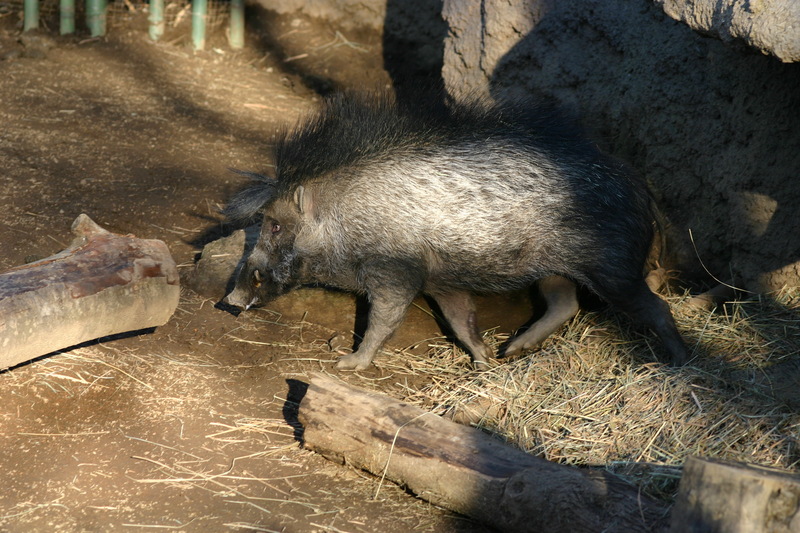|
| Query: Sus cebifrons | Result: 1st of 7 | |
Visayan Warty Pig (Sus cebifrons) - Wiki
| Subject: | Visayan Warty Pig (Sus cebifrons) - Wiki
| |

| Resolution: 3072x2048
File Size: 2090700 Bytes
Date: 2007:01:26 17:56:49
Camera: Canon EOS DIGITAL REBEL (Canon)
F number: f/4.5
Exposure: 1/320 sec
Focal Length: 105/1
Upload Date: 2007:09:16 18:17:52
|
ERROR : Server Busy(-1105)
Visayan Warty Pig
From Wikipedia, the free encyclopedia
[Photo] Visayan Warty Pig (Sus cebifrons) at Oregon Zoo. Photo by Brian Gratwicke http://en.wikipedia.org/wiki/User:Brian.gratwicke
The Visayan warty pig, Sus cebifrons is a critically endangered species of pig. The Visayan warty pig can only be found on two of the Visayan Islands in the central Philippines, and as a result, faces unique challenges to their survival in the wild. The challenges include little room to escape from predators, food shortages and hunting - these are the leading causes of the Visayan warty pig's status as critically endangered. Due to the small numbers of remaining Visayan warty pigs in the wild, little is known of their behaviors or characteristics outside of captivity.
Distribution
The Visayan warty pig is endemic to six islands in the Philippines archipelago. It is now extinct in four of the islands. There are 2 subspecies, one on Negros and one on Cebu.
Physical Characteristics
The Visayan warty pig receives its name from the three pairs of fleshy "warts" present on the visage of the boar. Biologists speculate that the reason for the warts is to assist as a natural defense against the tusks of rival pigs during a fight. The boars also grow stiff spikey hair.
Habitat and Diet
The Visayan warty pigs tend to live in groups of four to six. The diet of the pig mainly consists of roots, tubers, and fruits that can be found in the forest. They may also eat cultivated crops. Since approximately 95% of their natural habitat has been cleared by local farmers who cut down the forest to plant crops, the propensity of the pigs to eat cultivated crops has risen dramatically. Because the land that is cleared for farming is often unproductive after a few years, the food sources of the Visayan warty pig are extremely limited, a factor that has contributed significantly to the pig’s dwindling numbers.
Reproduction
Visayan warty pig piglets are often seen during the dry season between the months of January and March in their native habitat of the western Visayan Islands. The mean number of piglets is three to four per litter.
Captive status
In Europe, there are only 4 zoos to keep the species. They all keep the Negros Island variety. The four zoos are Rotterdam, Poznan, Chester and Edinburgh. In America, There are more zoos that hold this animal. None are the Negros Island Subspecies. San Diego was the first zoo outside the Philipines to keep and breed Visayan warty pigs. Los Angeles and Rotterdam have also bred the species.
http://en.wikipedia.org/wiki/Visayan_Warty_Pig
| The text in this page is based on the copyrighted Wikipedia article shown in above URL. It is used under the GNU Free Documentation License. You may redistribute it, verbatim or modified, providing that you comply with the terms of the GFDL. |
|
Comments |
|---|
| | Guest |
|
| bunny pigggsssssssssssssssssssssssssssssssssssssssssssssssssssssssssssssssssssssssssssssssssssssssssssssssssssssssssssssssssssssssssssssssssssssssssssssssssssssssssssssssssssssssssssssssssssssssssssssssssssssssssssssssssssssssssssssss sooooooooooooooooooooooooooooooooooooooooooooooooooooooooooo cuteeeeeeeeeeeeeeeeeeeeeeeeeeeeeeeeeeeeeeeeeeeeeeeeeeeeeeeeeeeeeeeeeeeeeeeeeeeeeeeeeeeeeeeeeeeeeeeeeeeeeeeeeeeeeeeeeeeeeeeeeeeeeeeeeeeeeeeeeeeeeeeeeeeeeeeeeeeeeeeeeeeeeeeeeeeeeeeeeeeeeeeeeeeeeeeeeeeeeeeeeeeeeeeeeeeeeeeeeeeeeeeeeeeeeeeeeeeeeeeeeeeeeeeeeeeeeeeeeeeeeeeeeeeeeeeeeeeeeeeeeeeeeeeeeeeeeeeeeeeeeeeeeeeeee aaaaaaaaaaaaaaaaaaaaaaaaaaaaaaaaaaaaaaaaaaaaaaaaaaaaawwwwwwwwwwwwwwwwwwwwwwwwwwwwwwwwwaaaaaaaaaaaaaaaaaaaaaaaaaaaaaaaaawwwwwwwwwwwwwwwww |
^o^
Animal Pictures Archive for smart phones
^o^
|
|
|

